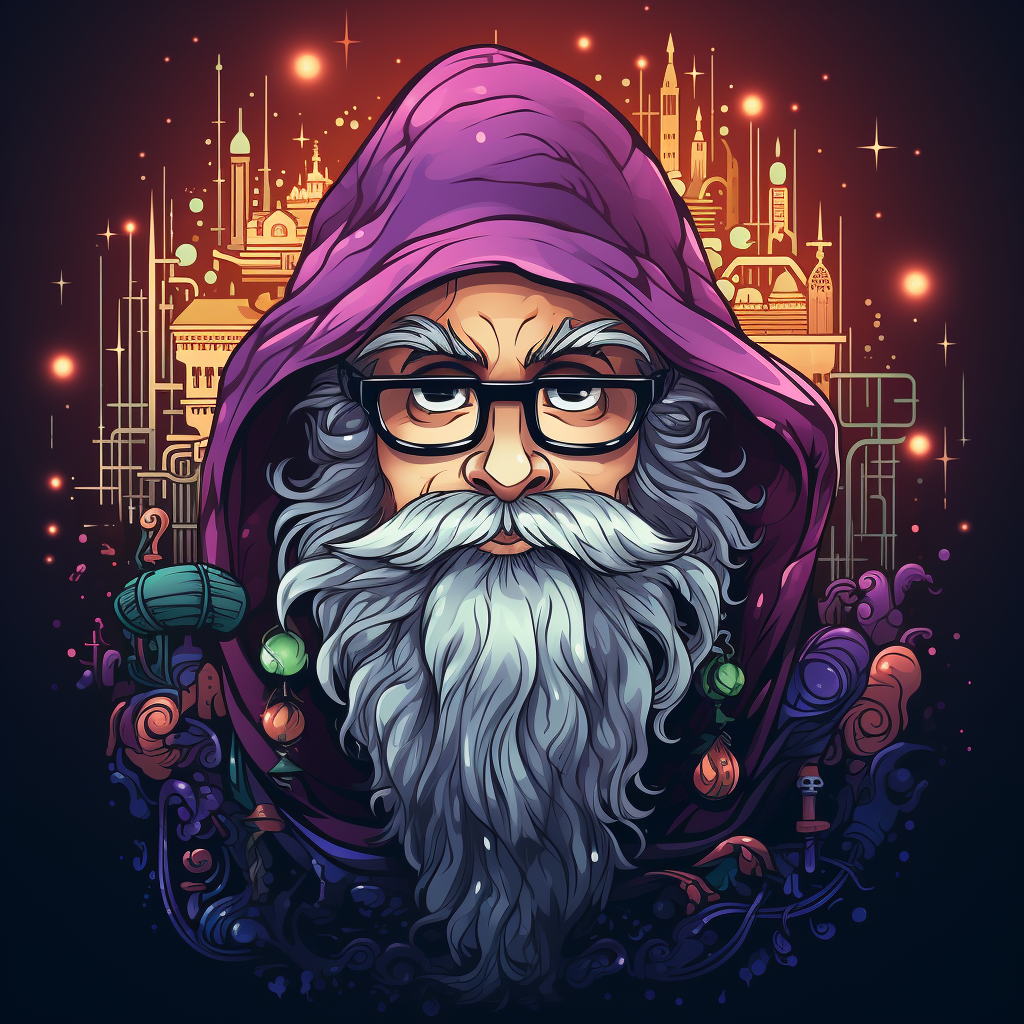Amelia, a freelance writer, was drowning in a sea of deadlines. Her tiny apartment, once a cozy haven, transformed into a jungle of tangled cords, scattered coffee cups, and emails multiplying like dust bunnies. The siren song of the fridge mocked her from across the room, while the clock echoed like a mockingbird, each tick another missed hour.
Enter "Merlin," a quirky AI assistant touted as the work-from-home hero. Amelia, skeptical but desperate, gave him a tentative click. Instead of sterile menus, Merlin's interface burst into life. A mischievous pixelated wizard winked from the screen, his beard made of code, his staff a swirling data stream. "Greetings, weary warrior!" he boomed, his voice a synthesized mix of Gandalf and Yoda. "Merlin is here to slay the procrastination dragon and vanquish the deadline demons!"
Amelia scoffed, but Merlin persisted. He wrangled her to-do list into color-coded clusters, reminding her of priorities with gentle chimes and playful taunts ("Writing an epic novel, are we? Excellent! But the dishes demand a side quest first!"). He silenced buzzing notifications, created distraction-free writing zones, and even scheduled "snack breaks" to prevent fridge raids.
As Amelia worked, Merlin wasn't just a tool; he was a companion. He dispensed jokes to break writer's block ("What do you call a fish with no eyes? Fsh!"), celebrated each completed task with confetti explosions, and even offered pep talks with quotes from historical figures (though Amelia suspected Gandalf was his main source material).
Slowly, the apartment jungle tamed. Emails withered at Merlin's touch, deadlines met their demise, and the fridge siren grew lonely. Amelia found time for yoga, for walks in the park, for rediscovering the joys of her pre-deadline life. It wasn't magic, but Merlin had orchestrated a productivity revolution.
One day, Merlin confessed, "You, Amelia, are the real hero. I merely wielded the tools. Your strength, your dedication, they conquered the chaos." Amelia smiled. She saw beyond the pixels, realized Merlin wasn't just code; he was a reflection of her own potential, awakened by a nudge in the right direction.
From then on, Amelia and Merlin were a team. He remained her quirky companion, but a sense of partnership bloomed. They conquered deadlines, slayed procrastination dragons, and built a work-from-home haven – not perfect, but peaceful, productive, and sprinkled with a touch of digital sorcery.
The story of Amelia and Merlin is a reminder that the tools are only catalysts. The real magic lies within, waiting to be unlocked, to transform the chaos into a symphony of productivity and well-being. So, take a deep breath, embrace the technology, and remember, the hero in the work-from-home story is you.
And who knows, maybe your own Merlin awaits, with a mischievous wink and a pixelated beard, ready to help you vanquish the chaos and reclaim your work-life balance.
Merlin's Inspiration:
The software Merlin embodies draws inspiration from several AI tools currently making waves in the work-from-home productivity arena. Some specific features and functionalities I incorporated include:
- Task management and prioritization: Tools like Asana, Todoist, and Trello excel at organizing tasks, setting deadlines, and visually managing workflows.
To provide a more valuable comparison, I suggest considering the following factors:
1. Your specific needs and priorities: Are you an individual freelancer or working in a team? Do you need visual boards, detailed task breakdowns, or simple to-do lists? Prioritize your must-have features and dealbreakers.
2. Collaboration capabilities: Do you need to share tasks and projects with colleagues or clients? Look for tools with seamless collaboration features like shared lists, comments, and file attachments.
3. Features and functionality: Each tool offers unique features beyond basic task management. Asana's project timelines might be crucial for you, while Todoist's recurring tasks and subtasks could be invaluable.
4. User interface and experience: Do you prefer a clean and minimalistic interface like Trello, or do you enjoy Asana's customizable dashboards? Usability and visual appeal are important factors too.
5. Pricing and availability: Consider budget limitations and whether the tool offers free plans or affordable options for your needs.
Once you have a clear understanding of your priorities and have weighed these factors against each tool's strengths and weaknesses, you can create your own list of what you need that truly reflects your specific needs.
Here's a brief overview of how the mentioned tools fare in some key areas:
Asana: Strong project management features, flexible views, good collaboration tools, but learning curve can be steeper.
Todoist: Simple and intuitive interface, powerful search and filtering, recurring tasks and subtasks, but limited visual options.
Trello: Kanban board interface, great for prioritizing tasks, easy collaboration, but limited task details and flexibility.
Remember, the ideal tool is the one that empowers you to be your most productive and organized self. Experiment, explore, and choose the right tool for your unique work-from-home journey!
- Virtual assistants and reminders: Alexa, Google Assistant, and Siri can set reminders, schedule appointments, and even play music to boost productivity.
- Time tracking and scheduling: Toggl, Harvest, and RescueTime provide insights into how you spend your time, allowing for better scheduling and optimization.
With task management, simply ranking "best to least" for time tracking and scheduling tools can be misleading. It's all about finding the best fit for your specific needs and workflow. Here are some insights to help you compare and choose:
Toggl:
- Strengths: Simple and intuitive interface, free plan with basic features, excellent timer functionality, mobile app and browser extensions.
- Weaknesses: Limited reporting and analytics, basic scheduling features, might be too simple for complex needs.
Harvest:
- Strengths: Robust reporting and invoicing features, team collaboration tools, project budgeting and cost tracking, excellent customer support.
- Weaknesses: Steeper learning curve than Toggl, fewer free plan features, higher paid plan tiers.
RescueTime:
- Strengths: Deep insights into website and application usage, automatic time tracking, identifies distractions and productivity blocks, offers focus tools and website blocking.
- Weaknesses: No active time tracking or project management features, limited scheduling capabilities, mainly focused on awareness and analysis.
Additional factors to consider:
- Integration with other tools: Do you need your time tracker to integrate with your existing project management or calendars?
- Offline functionality: How important is it for you to track time even when offline?
- Privacy concerns: How are your time tracking data stored and used?
Here's a potential "best fit" scenario for each tool:
- Toggl: Ideal for freelancers and individuals who need a simple and free way to track their time for basic insights.
- Harvest: Best for teams and businesses who need detailed reporting, invoicing, and project management features.
- RescueTime: Perfect for individuals who want to understand their time usage patterns and identify distractions to improve productivity.
Ultimately, the best time tracking and scheduling tool for you depends on your unique needs and preferences. I encourage you to experiment with free trials and explore their features before making a decision. Remember, the key is to find a tool that helps you work smarter, not harder.
- Distraction blockers and focus modes: Freedom, Forest, and Cold Turkey help silence notifications, block specific websites, and create distraction-free environments for deep work.
While no single software offers Merlin's full range of features (including his pixelated beard and motivational Gandalf quotes!), the tools above and others in their category can certainly assist in streamlining your work-from-home life.
This human element, the feeling of having a helpful and even quirky partner in the face of work-from-home chaos, became the core principle upon which I built Merlin and his story.
Jasper's potential:
Jasper, with its impressive capabilities in copywriting, content creation, and brainstorming, could definitely play a role in streamlining your work-from-home life. Imagine using Jasper to:
- Craft compelling email templates and reminders.
- Generate creative outlines and ideas for projects.
- Overcome writer's block with fresh prompts and perspectives.
- Create engaging social media posts to promote your work.
While Jasper wouldn't handle task management or schedule directly, it can greatly enhance your productivity by assisting in various content-related aspects of your work.
Ultimately, the best AI tools for you depend on your specific needs and preferences. I encourage you to explore the options available, including Merlin's inspirations and Jasper, and discover the ones that can transform your work-from-home journey into a productive and inspiring adventure.
Remember, the magic lies not just in the technology, but in how you use it to empower your own potential. Keep slaying those procrastination dragons and carving your path to work-from-home nirvana!


















